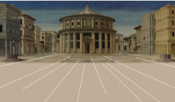
World culture: The exhibition on the history of the painted panel of The Ideal City in Urbino
The painted panel of The Ideal City in the Galleria Nazionale delle Marche is one of the most fascinating enigmas of the Italian Renaissance. We do know neither why is was painted nor by whom, yet it is a compendium of art, science and philosophic speculation, one of the highest achievements of the civilization that flourished at Urbino in the second half of the fifteenth century, at the court of Duke Federico da Montefeltro, one of the most learned and enlightened lords of his time.
In the exhibition at the Palazzo Ducale in Urbino, curated by Lorenza Mochi Onori and Vittoria Garibaldi, the Urbino panel is finally open to public view along with another "ideal city", similar in style, from the Walters Art Gallery in Baltimore (unfortunately, a third in Berlin cannot be moved due to its poor state of conservation). A unique opportunity to broaden our knowledge of such singular and mysterious works, to explore the meaning behind the idea of a city as it is reflected in the architecture of the paintings, and to understand the meaning of the utopias depicted in them.
Alongside this panel, many other works are on display, about 50 in all, including paintings, sculptures, wood inlays, drawings, medals, illuminated manuscripts and architectural treatises, which give us a global picture of one of the high points in the history of this small capital city, set in the mountains and hills of Montefeltro, in the midst of the lands of Tuscany, Umbria, Marche and Romagna.
There are works by Jacopo de Barbari, Piero della Francesca, Luca Signorelli, Fra’ Carnevale, Domenico Veneziano, Sassetta, Mantegna, Perugino, Bramante and finally Raphael, who, having learnt his art in the cultural climate of Urbino, was to become one of the great architects of 1500s. Two works by Raphael feature in the exhibition: a drawing and the predella of the Oddi Altarpiece exceptionally loaned for the occasion by the Vatican Museums.
The venue, and at the same time a constituent element of the exhibition, is the splendid Palazzo Ducale in Urbino, built with the contribution of architects who invented the very language of the Renaissance: Leon Battista Alberti, Luciano Laurana and Francesco di Giorgio Martini, all three of whom have been attributed the painting of the Urbino panel.
The exhibition runs through July 8.

